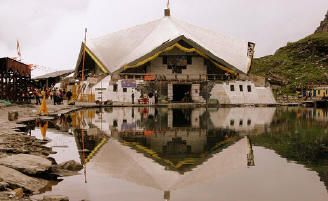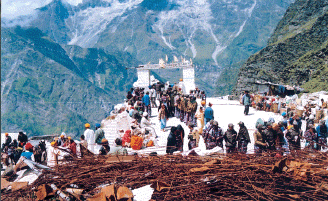Holy Destinations of India
Hemkund Sahib
The Hemkund Sahib is situated near the Valley of flowers, at an altitude of 4,329 m above sea level. The holy lake Hemkund is associated with the 10th Sikh guru, Guru Gobind Singh, the founder of the Khalsa (meaning 'the pure') Panth. It is believed that the guru had meditated on the banks of this holy lake in one of his earlier births. A Gurdwara is located on the banks of this lake. This is a very holy pilgrim spot of the Sikhs.
Hemkund is located in India's northern state of Uttaranchal in the Garhwal region. As the name suggests, Hemkund is a lake in the Himalayas. There are many lakes in the Himalayas, but few are set in as dramatic a setting as Hemkund is. At an altitude of 4,329 m above sea level, which is several hundred meters above the tree line, the lake is set like a jewel in a crown of seven of the most picturesque snow peaks of the Himalayas. In this surrealistic landscape, made up mostly of rock and ice, there is no habitation-animal or human. The place is as if made to order for a man in search of absolute peace to meditate upon the absolute truth.
There would not be another living thing in sight. The only sound one can hear would probably be one's own sound. Visiting this place could be regarded as the encounter with the personification of absolute peace and raw natural beauty. It does not take much imagination to understand how the place came to be regarded as a spiritual power place.
Hemkund is mainly a pilgrimage site, and people come here to pay reverence at the Gurdwara and the Lakshman Temple. Besides, one can enjoy the serene and exotic beauty of the place. The Valley of Flowers is also located near Hemkund. Those interested in adventure sports can visit Auli during winters and enjoy skiing in the Himalayas.
|
Photos of Hemkund Sahib |
|
 |
 |
HISTORY
It is this very place where Guru Gobind Singh, the tenth and last Guru of the Sikhs, became one with God after prolonged meditation in his previous birth. He mentioned it in his writings in glowing terms, but only vaguely alluded to its exact location. And so, it was not until 1930, when two devout Sikhs, Sant Sohan Singh and Havaldar Mohan Singh, chanced upon it during a cartography mission, that the place came to be venerated for having hosted the great spiritual leader. The place is now regarded as an important pilgrim place of the Sikhs. Hemkund is also a holy place for the Hindus. According to Hindu mythology, Hemkund (or Lokpal as it is also known) is where Lakshman had done his penance.
HOW TO REACH THERE
Hemkund is 19 km trek from Govindghat. The base for journey to Hemkund is Ghangaria which is 13km trek from Govindghat. Govindghat is connected with Joshimath on (Delhi-Bardinath highway) with 18km long motorable road.
Nearest Airport : Nearest airport is Jolly Grant, 307 kms. (Dehradun 334 kms.)
Nearest Railway Station : Nearest railhead is Rishikesh, 293 kms.
Road Connectivity : Hemkund Sahib is 6 Kms. from Ghangharia, which is approachable on foot or on pony from Govindghat which is connected by road with Rishikesh, Kotdwara, Dehradun, Haridwar, Nainital, Ranikhet and other important stations of Garhwal and Kumaon
| General Information | ||||||||||
|
Best Season, Climate and Clothing
Being situated at such a high altitude, the climate of Hemkund is cold and inconsistent. The best time to visit this place is from July to September, as it is the only time of the year when the flowers are in bloom and the weather is not so cold. But before venturing on the journey, one should take care to carry woollens and raincoats. Good, strong trekking shoes are also a necessity.
ACCOMMODATION / WHERE TO STAY
The Govind Ghat Gurudwara at Ghangharia privides accommodation facilities to tourists.
PLACES TO VISIT / MAJOR ATTRACTIONS
Gobindghat
The pilgrimage generally begins at Gobindghat, situated between Joshimath and Badrinath. From the bridge across the Alakananda (at Gobindghat), it is 14 km to the next settlement, Ghangharia, or Gobind Dham as the Sikhs call it. The trek runs all along the Bhyundyar Ganga, ascending and descending at regular intervals. One passes through a varied forest of many types of trees and several meadows covered with dandelions. The forest floor is thick with ferns and huge rocks covered with many types of moss. The walk, though difficult, is nevertheless refreshing; one is awestruck with rapturous exclamations over the pristine beauty of the mountains and springtime flowers.
From Ghangharia, Hemkund is only 5 km away. However, the journey is quite arduous because of a steep gradient. The trek from here to Hemkund is through forests of pine and rhododendron where wild roses, ferns, and alpine flowers bloom. The surging waters of the Lakshman Ganga are also visible.
Gurudwara Hemkund Saheb
The Gurdwara Hemkund Saheb is situated besides the lake, amidst a magnificent panorama. The Gurdwara is devoid of any ostentatious embellishments, befitting the austere surroundings.
Hemkund Lake
The Hemkund Lake (also called the Lokpal Lake) is about 2 km in circumference. Its clear water reflects the Saptashringa Peaks (5,500 m) that surround it.
Lakshman Temple
On the banks of the Hemkund lake stands the little-known Lakshman Temple (also known as Lokpal Temple). It is said that Lakshman had meditated at this place. The mythical Sanjeevani Buti (an ambrosia yielding plant) that cured Lakshman after he was wounded during a fight with Meghnad is said to have been found in the vicinity.
Valley Of Flowers
Along the way from Gobind Dham to Hemkund Sahib is a path, which turns towards the Valley Of Flowers flanked on either side by majestic snowcapped peaks. The valley is carpeted with more than 300 species of wild flowers like the Himalayan Blue Poppy, Snake Lilly, white and yellow Anemones, Daisies, Calendula and Dianthus. A wide variety of butterflies, snow leopard, brown and black Himalayan bear, tahr, musk deer, bharals and serow are the other attractions of the national park.
Within the main valley are smaller valleys carved out by streams of melting glaciers. On the banks of these valleys, you can encounter exciting pattern of flowers. One such valley exists along the Donagair Garh, the last of many streams. On its banks are some of the most magnificent plants.
Another valley Nag Tal is literally the place of the venomous serpent - the Nag. It is believed to be infested with poisonous flowers. These flowers cause harm when plucked, crushed or smelt. The valley was introduced to the world by Frank S. Smith - mountaineer, explorer and botanist who camped here in 1937. He authored a book called The Valley of Flowers, which unveiled the beauty and floral splendours of the valley to the world. In 1939, Margarate Legge, a botanist arrived at the valley for further studies. She slipped off and was lost in the garden. Her sister later erected a memorial on the spot where she was buried by the locals. The memorial is still there.
FAIRS AND FESTIVALS
In February-March every year, a winter sports festival is held when exhilaration and speed scale the peaks of frenzy. Besides, the temples observe and follow the Hindu festivals and celebrate it in the presence of a large number of devotees.